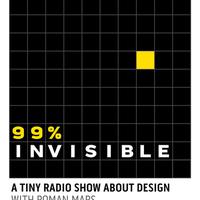99% Invisible-04- 99% Details
Roman Mars (RM): This is 99% Invisible. I'm Roman Mars. John Edson (JE): The details are not the details. They make the design.
RM: That's John Edson. JE: Thats what he said.
RM: Quoting legendary designer Charles Eames.
JE: Express test and cycle
JE: Im John Edson. President of Lunar.
JE: Express test and cycle
JE: There's a conception in the public, I think, that design is a lot about making things pretty. That's shifting I think. There's a big DIY movement and a big maker movement and people are getting a better sense of how things come to be. We've always known how buildings came to be, because we'd watch them go up. But products just kind of appear on the store shelf. From somewhere. From China, right? But I really love the process of design and love bringing things to life.
JE: Express test and cycle
RM: The story I want to tell, about the details that go into product making, is about a toothbrush. But there's a bit of a conflict of interest, or at least the perception of one, that requires a disclaimer. So I asked Matt Martin at KALW to help me out.
Matt Martin: What matters to me, Roman, is that you are completely open about the fact that John Edson is the president of Lunar. Lunar underwrites these segments, but at the same time, you've got complete editorial control over how 99% Invisible sounds. So what do you think you're going to say? RM: Oh I'll think of something. You know, what he said.
RM: This is the story of a toothbrush.
JE:Express
JE: Expressng is getting a design out there in the world in a prototype form so that other people can look at it.
JE: Test
JE: And you can test it and you can evaluate it to decide what you're going to do next. JE: And cycle
JE: And it really is a kind of forced evolutionary process.
RM: So the toothbrush company came to Lunar with what John Etson calls a make-pretty exercise.
JE: Make-pretty exercise.
RM:That's not really innovation. JE: Our instict was so ask them “well how do people hold toothbrushes?”
RM: But the toothbrush company didn't actually know this. JE: So we engaged a hand kinesiologist.
RM: That's somebody who knows how people hold stuff. It turns out there are five common toothbrush grips.
JE: And in the meantime, our designers went out and bought every toothbrush under the sun. And we started to take the conventional flat toothbrush with bristles sticking out of it and we used a heat gun and made a bunch of different prototypes. We just bent those standard brushes into different shapes to see fundamentally what was working and what was not working. Hundreds of sketches and dozens of prototypes. One of the first things we found when we were molding our protoypes was that at the time the Reach toothbruch was known as the most ergonomic toothbrush.
RM: This was all perception.
JE: It was only ergonomic in that it looked like a dental tool. And it was a dental tool that somebody would use on you. the crook and the dental mirror. It's so that somebody can stick it in your mouth and manipulate it so they can see around your teeth. So the reach toothbrush, if you use it yourself, you end up with your hand back at your ear.
RM: So scrap the bend. Straight handle is better.
JE: One of the things we found was that a fatter toothbrush handle is more comfortable
RM: So fat is better than thin. But at some point in the process, someone at the toothbrush company said, “Wait a minute. We can't ship a toothbrush that's got a fat handle on it, because it's not going to fit on those 1950s style ceramic toothbrush holders that people have in their walls.” Part of their houses, right? RM: But this turned out to be a good thing for hte toothbrush mongers.
JE: They got a ton of press about it. “Oh here's the toothbrush that doesn't fit.” RM: And lunar came up with a stratefy
JE: And if anybody called to complain, we created this little nickle-plated stamp and just sent out this $5 component.
RM: Just like biological evolution. Sure, the organism adapts to the environment, but the environment adapts to the organism.
JE: And now if you buy a toothbrush holder, it's going to have these giantic holes in the top, right? So you can fit these new-fangled toothbrushes in them.
JE: Future oriented.
RM: In addition to the straight and fat handles, the new toothbrushes had criss-cross bristles.
JE: Angled bristles.
RM: That was brand new. The handle was strategically flattened in parts to help you orient it.
JE: Your fingers know which way the bristles are pointing in your mouth.
RM: And it accomodated all five grips identified by the kinesiologist.
JE: There's the spoon grip, there's the death grip. More women than men use the death grip.
RM: When I asked John Edson which was his favorite innovation in the toothbrush, he named something that most people would consider a lack of design or innovation: just getting the toothbrush back to having a straight handle.
JE: It's not trying to do anything crazy through the neck. That's the best shape, really. Kind of those “duh” innovations.
RM: And that's a big part of design. The thing you don't think about or notice probably had the most htought put into it. RM: 99% Invisible is produced by me, Roman Mars, with support from Lunar. It's a project of KALW, The American Institute of Architects in San Francisco, and the Center for Architecture and Design. Find out more at 99percentinvisible.org

